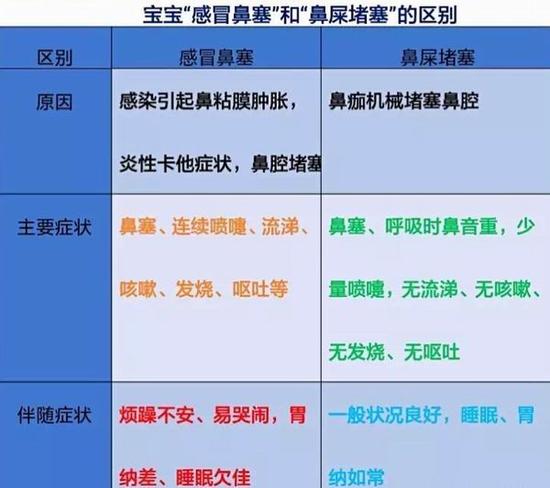Autumn is the season of frequent colds. Because the baby's immune system is not well developed and has weak resistance, it is more likely to cause respiratory tract infection. When baby is sick, she is irritable, crying, vomiting and so on! Parents are worried and anxious. They toss about several times every night and turn into panda eyes the next day.
The baby has a stuffy nose, "wheezing, wheezing", and his mouth contains milk when feeding. His nose is blocked and he can't breathe with his nose, so he can't eat well! When sleeping, open your mouth to breathe and drool. If you don't sleep well, you will make trouble. You can't sleep well! What should we do if parents are worried? When a baby has a stuffy nose, his mother has a stuffy heart.
The nasal cavity of infants is narrow, and the nasal mucosa is rich in blood vessels. It is extremely vulnerable to external factors, resulting in nasal mucosa edema, exudation, increased nasal mucus, nasal scab retention, and obstruction of nostrils. Parents believe that the baby's nasal congestion can be divided into two types: nasal mucus blockage and nasal congestion caused by disease. The main disease factors of baby's nasal congestion are infection, allergy, nasal polyps, congenital anatomical structural malformations, etc.
Many parents in the child care clinic will ask how to deal with the baby's nasal congestion? When breathing, the nasal sound is very loud. In fact, most of them are not "stuffy nose" in the sense of disease, but blocked nasal excrement. A parent asked me: "How can such a small baby have nasal excrement?" It is mainly because the nasal hair in the nasal cavity of the baby is not fully developed, and the baby does not have enough ability to resist the dust and foreign bodies in the air when breathing. The nasal mucosa exudate mixed with dust to form a nasal scab, which blocked the nasal cavity as the nasal scab grew larger. The baby can't pick his nose and excrement by himself, so he can't solve himself.
The most common cause of "nasal congestion" caused by baby's disease should be upper respiratory tract infection, commonly known as "cold nasal congestion". How can parents distinguish between "cold stuffiness" and "nasal mucus blockage"?
When your baby's nasal mucus is blocked, how can parents help your baby remove it? If your baby's nostrils are large enough, parents can directly see or shine a flashlight on the baby's nostrils to see the nasal scab blocked in the nasal cavity. In the outpatient service, a father used forceps to help the baby dig out the nasal excrement. The nasal scab was too dry and hard, and the baby slightly resisted. The nasal excrement was taken out, but the baby's nasal mucosa was bleeding, and his family cut his head and covered his brain.
Today, let's teach you a safe way to help your baby remove nasal excrement. Parents need to learn!
1. Moisturize the nasal cavity: parents can use a dropper to drop 1-2 drops of distilled water or breast milk into the blocked nasal cavity of the baby to wet the blocked dry hard crusts. The mouth of the dropper is placed on the lower edge of the baby's nostrils and slowly drips in. Do not drip too fast or too much to make the baby uncomfortable.
2. Prepare security weapons: parents can choose a high-quality adult sterile cotton swab, wash their hands, hold the cotton swab with one hand, and hold the cotton head side of the cotton swab with the index finger and thumb of the other hand to rotate around the cotton swab and pull the cotton outward, so that the cotton is pulled out of the cotton swab, and twist the pulled cotton flower into a cotton bundle with your fingers, with a length of about 1cm.
3. Take out the nasal excrement: parents can choose to put the cotton bundle into the baby's nasal cavity when the baby is relatively quiet. Only the cotton has no rod when entering the nostrils, so that the dry cotton can contact and adhere to the wet nasal scab. Rotate the cotton rod slightly, and slowly take out the cotton bundle to bring out the nasal scab. Sometimes the connection between the nasal scab and the nasal mucosa cannot be removed. The process of the cotton bundle stimulating the nasal mucosa can make the baby sneeze. The impact of sneezing can make the nasal scab fall off and rush out of the nasal cavity.
When your baby has a cold, the obvious nasal congestion usually lasts for 3 to 7 days. How can parents help your baby alleviate the nasal congestion?
1. Warm towel applied to the nose: after the nasal mucosa shrinks with heat, the nasal cavity will be relatively smooth, and the thick nasal mucus will also be easier to hydrate and flow out, which can relieve nasal congestion. When applying hot compress, be sure to keep your movements gentle, otherwise your baby will easily resist random movements. Take care not to cover your baby's nostrils and eyes with a towel.
2. Body position change: parents can try to change the baby's body position, lie to the right when the left side is stuffy, lie to the left when the right side is stuffy, and the bilateral stuffy nose can lift the baby's head 30 degrees to alleviate the symptoms. The baby is crying all the time. At this time, the baby can be held upright, which can also reduce the nasal congestion and make the baby fall asleep easily.
Parents will ask: "How do you know which side of the baby's nose is blocked?" In fact, it is very simple. Parents can use glasses lenses to put in front of the baby's nostrils. When the baby breathes, the exhaled gas will make the glasses lenses produce corresponding water vapor. If the side of the nose is blocked, the water vapor will become smaller or disappear according to the degree of nasal congestion.
3. Home environment: pay attention to indoor ventilation, try to maintain the room temperature at 24~26 ℃ and humidity at 60%~70%. When it is cold, you can use an air conditioner or a heater to change the room temperature to alleviate the symptoms of children's stuffy nose and runny nose; When the air conditioner is turned on in hot weather, the windows should be opened regularly for ventilation, and the air quality should be good enough for outdoor activities.
4. Local treatment for relieving symptoms: nasal cavity can be sprayed with physiological seawater to reduce nasal mucosa edema. Teach older babies to blow their own mucus when they have it in their nasal cavity. There should be a correct way to blow your nose. Press one side of the nasal wing tightly and blow out the secretions of the opposite nasal cavity gently. This can reduce the accumulation of nasal secretions in the nasal cavity and lead to nasal congestion. It is forbidden to blow your nose at both sides of the nostrils together. It is easy to cause catarrhal nasal mucus to flow back into the middle ear cavity through the eustachian tube and cause middle ear disease.
5. Nasal Acupoint Massage: The big baby takes a sitting position (the little baby takes a flat position), massages both sides of the nasal wing from top to bottom with his thumb and food fingers for 3 minutes, and then rubs and presses Yingxiang acupoints (both sides of the nasal wing) for 1 minute. When the nasal cavity is hot, the breath will pass. Do it every 2-3 hours to effectively relieve nasal congestion.
6. Home care: infants less than 6 months old: squeeze about 50-100 ml of breast milk into a small bowl, take 1-2 pieces of green onion white (with roots), put them into the milk after washing, steam them for 5-10 minutes after water separation (you can smell the smell of green onion), take them out and let them cool down, and then feed them with a spoon, which has the effect of relieving symptoms, promoting resuscitation and treating cold and nasal congestion. Infants older than 6 months: feed more water, supplement vitamin C, eat a light and easy to digest diet, and parents accompany the baby to play and tell stories to distract the baby's attention.
In general, nasal congestion in infants is not a major problem. If parents can not improve the symptoms by using the above methods, especially if the nasal congestion is too long, or even affects sleep, breast feeding and mental state, parents should pay attention to it. It is recommended that children's five management departments should seek medical advice and receive further examinations, Early diagnosis of the causes (infection, allergy, nasal polyps, congenital anatomical structural malformations, etc.) and early treatment.
Wang Weijie/attending doctor of Maternal and Child Health Department of Shanghai First Maternal and Infant Health Hospital





